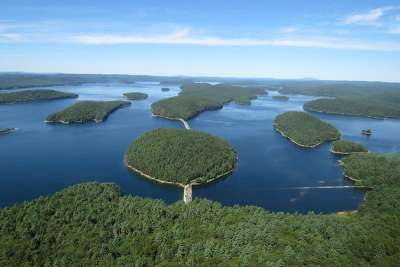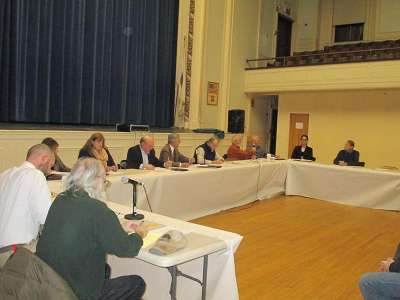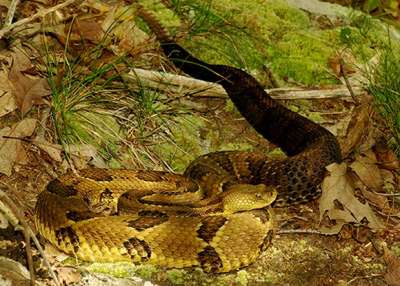
On an early spring evening in March 2017, a large crowd packed a public meeting in Ware, Massachusetts, to discuss a controversial proposal to establish a rattlesnake colony at the nearby Quabbin Reservoir. Ever since word of the project first came to light in early 2016, rattlesnakes had become the subject of passionate debate in Massachusetts, and this meeting was no exception. Nearly 30 attendees provided comments (one in the form of a song), which were roughly split for and against the project. Opponents cited a variety of concerns, mostly centered on public safety. Supporters argued the importance of protecting an endangered, relatively harmless native species and maintaining the state’s biodiversity.
Such are the conflicting emotions evoked by the timber rattlesnake, whose Latin name alone, Crotalus horridus, suggests trouble. Public attitudes have complicated efforts to protect one of the most feared, misunderstood, and endangered creatures of the eastern forests. At the root of the opposition are fears and misconceptions that have long been associated with snakes in general, especially venomous species. Fear of snakes, or ophidiophobia, is one of the most commonly reported human phobias, sometimes even outranking death. A recent study by researchers at a national park in Nepal indicated that nearly 90 percent of respondents feared snakes, and half supported the extermination of all venomous species. Ecologists and psychologists, including esteemed Harvard biologist E.O. Wilson, have suggested this trait is an innate human survival instinct that evolved long before antipathies to more dangerous modern threats such as guns or knives.
In spite of this, rattlesnakes also have their share of advocates. In the mid-eighteenth century, rattlesnakes were portrayed by figures such as Benjamin Franklin and John Paul Jones as a symbol of resistance and unity during the American Revolution. Today, naturalists and ecologists appreciate them as members of a species that represent, in the words of Berkshire Community College professor and snake expert Tom Tyning, “an emblem of the last vestiges of wilderness left in the twenty-first century.” As most supporters are quick to point out, fears about rattlesnakes are disproportionate to the actual threat they pose to humans. Unlike the aggressive venomous snakes found in other regions of the world, timber rattlers are docile and passive by nature. They avoid humans whenever possible, and their trademark tail-shake is a warning to deter potential threats and avoid confrontations that might result in the loss of precious venom or an injured fang. Actual bites on humans are exceedingly rare and almost always the result of snakes’ being handled, provoked, or stepped on. In Massachusetts, only three known deaths have been attributed to rattlesnakes, all occurring before the mid-nineteenth century and all likely the result of primitive medical treatments following the bites. In modern times, despite the proximity of some dens to heavily used hiking trails and populated areas, there have been just a handful of bites – none fatal. In Vermont, there are no definitive records of fatal snakebites.
Once widespread throughout the forests of the Northeast, timber rattlesnakes have declined markedly since colonial times. They have been heavily persecuted by human hunters motivated largely by bounties that were offered as recently as the 1970s in Vermont and New York. Even after receiving protection in many states as an endangered or threatened species, rattlesnakes have continued to suffer from illegal killing, motor vehicle mortality, and collection for the exotic pet trade. At the northern end of their range, rattlesnakes depend on deep, rocky dens to survive cold winters, a specific habitat requirement that makes them vulnerable to development and easy targets for hunters and poachers, some of whom have taken thousands of snakes. Yet another concern is a recently discovered fungal disease that has affected several snake species, though its overall effect on timber rattlesnakes is still being investigated.
Today, rattlesnakes have been extirpated from Maine, Rhode Island, and Canada; just two known populations remain in Vermont, and New Hampshire hosts a single small colony now suffering from inbreeding and the fungal disease. Connecticut’s overall population has declined by an estimated 85 percent from historic highs. In Massachusetts, just five colonies with an estimated 200 individuals remain. Two other Bay State populations have disappeared in the past 30 years, and two of the remaining sites are in imminent danger of being destroyed.
Fear and Loathing
As part of a federally funded project to study species affected by fungal disease, scientists at the Massachusetts Division of Fisheries and Wildlife have been working on a rattlesnake conservation strategy that includes a proposal to establish a new population in a fully protected area. According to Natural Heritage and Endangered Species assistant director Tom French, a new colony would add much needed genetic diversity and serve “as a safety net where [rattlesnakes] can be safe from people, road mortality, and deliberate killing.”
The site initially proposed for the sanctuary was Mount Zion, a large, rocky island on the east side of Quabbin Reservoir, the 40-square-mile wilderness area that protects Boston’s water supply. Mount Zion was abruptly transformed into an island during the 1930s, when the Swift River Valley was taken over by the state and flooded during the reservoir’s creation. Like the Quabbin’s other islands, it has been closed to the public and nearly undisturbed for the past 80 years. At 1,400 acres, Mount Zion is large enough to sustain a healthy rattlesnake population, and it offers ideal habitat, including hardwood forests full of prey species, sunlit ledges, and most importantly, deep, rocky den sites.
The plan was to release no more than 10 snakes annually to Mount Zion beginning in 2017, with a long term goal of developing a population of 150 individuals. In an enclosure at the Roger Williams Zoo in Providence, Rhode Island, the first phase of the project is already underway. Here, newborn snakes, taken from existing colonies, are being raised in captivity for two years until they grow large enough to increase their otherwise slim odds of surviving in the wild (only about one in five reach adulthood outside of captivity).
However, when word of the project first reached central Massachusetts communities in January 2016, it prompted an immediate uproar, fueled by a combination of snake stigma and local politics. Hundreds of people attended spirited public meetings in the communities bordering Quabbin Reservoir. Legislators were swamped with phone calls, letters, and emails (with attached videos of swimming rattlesnakes in some instances) from citizens concerned that the snakes would migrate to the mainland. The story attracted national and worldwide media coverage, often with hyperbolic, attention-grabbing leads that, not surprisingly, played up snake hysteria. “Dear Massachusetts Residents: Venomous Snakes Coming to an Island Near You” read the headline of one Washington Post article that went on to describe “alarmed residents whose heads have been filled with nightmare visions of meeting a sharp-toothed end.” On the same day, The Independent teased a story with “Fears rattlesnake colony may escape and kill everyone.”
Concerns that the snakes would disperse from Mount Zion to public areas of the Quabbin Reservoir and the surrounding towns were indeed on the minds of many area residents who opposed the project. Mount Zion is connected to the mainland by baffle dams that redirect water as part of the Reservoir’s natural purification process, and rattlesnakes are indeed adept swimmers. As a Ware resident told The New York Times, “all it takes is two snakes to get across [the Reservoir], and then all of a sudden you have snakes all throughout the town.” Some hikers, sportsmen, and business owners feared that public access at the Reservoir, a popular recreation destination and component of the region’s economy, would be restricted.
Another significant element of the opposition focused on the longstanding political tensions that have existed in central Massachusetts since colonial times. These antipathies peaked during the 1930s, when thousands of area residents were displaced during the creation of the Quabbin Reservoir, receiving low compensation for their land during the heart of the Great Depression. Local residents and public officials learned of the rattlesnake project through the media, reviving feelings of mistrust for the state government. Quabbin Reservoir historian J. R. Greene described the initial local reaction as “a lot of resentment – another example of Boston lording it over this part of the state.” In a televised interview, two leading proponents of a petition to stop the project, including a resident whose family lost several properties to the Reservoir, both cited the region’s historic lack of a voice as motivation for their opposition.
Proponents of establishing the rattlesnake colony argued that fears of snakes swimming across the reservoir and taking over local communities were irrational. Rattlesnakes are largely homebodies that remain in close proximity to their dens, traveling an average of two miles from home in the summer months. They would be unlikely to leave Mount Zion because of the abundant prey there, and any snakes that did disperse would likely not survive winter because of the lack of den habitat in surrounding areas. They also pointed out that officials were adamant from the start that there are no plans to restrict access at Quabbin Reservoir. Concerns about the snakes’ breeding rapidly on the island or elsewhere were also unfounded, supporters noted, as timber rattlesnakes have low reproductive rates. Females don’t become sexually mature until about 10 years of age, then they bear an average of fewer than 10 offspring (a small percentage of which survive to adulthood) every three to five years. As these details became known, some of the local opposition subsided. A selectperson from one of the Reservoir’s abutting towns described “some initial confusion and concerned feedback from residents, but once they looked into the facts, people started to change their minds.”

The Quabbin Project is QUASHED
Many organizations voiced support for the project, including the Nature Conservancy, Mass Audubon, Quabbin Watershed Advisory Committee, Worcester County League of Sportsman’s Clubs, and Athol Bird and Nature Club. In a letter to state officials, Mount Grace Land Conservation Trust Executive Director Leigh Youngblood summed up that organization’s position: “In the rural areas of north central Massachusetts, recreation, wildlife habitat, and active land stewardship have long co-existed and help define the very rural character we cherish here. We welcome these quiet neighbors and hope they thrive.” And despite admitting to a fear of snakes in a radio interview, Massachusetts Governor Charlie Baker has been in favor of the plan from the outset.
In spite of these endorsements, the unexpected opposition from the general public prompted several politicians from central and western Massachusetts, including Anne Gobi, co-chair of the Joint Committee on Environment, Natural Resources and Agriculture, to call for the temporary suspension of the plan.
At an oversight hearing in May 2016, state officials apologized for the lack of communication and convened a working group to solicit additional public feedback and provide a recommendation for whether the project should go ahead. Several more public meetings, including the aforementioned gathering in Ware, were held in early 2017, and an online survey elicited hundreds of additional comments. In spite of the outreach, many people remained staunchly opposed to the rattlesnakes. When word got out that Mount Tom in western Massachusetts was also being considered as a potential release site, the Holyoke City Council immediately voted to oppose the project.
On a mild late-April day, when the first released snakes might have been basking on Mount Zion’s ledges, the Massachusetts Fisheries and Wildlife Board unanimously voted to suspend the Quabbin project indefinitely. Instead, as described by working group member Dave Small, the state will work to “develop a comprehensive, peer-reviewed recovery plan for the entire Massachusetts rattlesnake population that may or may not include the establishment of a new colony somewhere in the state.” The state’s new priority will be to increase protection for the existing colonies, including stiffer penalties for people who disturb rattlesnakes and other endangered species. In the meantime, the snakes that were raised at the Roger Williams Zoo will be returned to existing populations.
The opposition to the project has demonstrated how public attitudes toward snakes and other unpopular species can complicate efforts to protect them, even in the face of scientific evidence and in a progressive state with a long tradition of wildlife conservation. As nature writer Ted Williams put it, “If you can look with equal appreciation and concern at timber rattlesnakes and, say, New England cottontail rabbits, both gravely imperiled in the Northeast, you’ve arrived as a naturalist. Many Americans aren’t close to that.” In recent years, perceptions of other once-maligned species, such as the great white sharks that have recently returned to Cape Cod’s waters or the wolves that now attract throngs of tourists to Yellowstone National Park, have changed for the better. Time is of the essence; one hopes that people will come to appreciate timber rattlesnakes before they entirely disappear from our woods.




